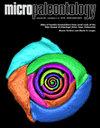The influence of organic matter compounds on foraminiferal and ostracode assemblages: a case study from the Marica-Guarapina Lagoon System (Rio de Janeiro, Brazil)
IF 1.6
4区 地球科学
Q3 PALEONTOLOGY
引用次数: 2
Abstract
The excessive nutrients discharge from industrial and domestic sources have been contributing to the establishment of eutrophication conditions, particularly in chocked lagoons in the Neotropical region. This study evaluates the influence of organic matter on the foraminiferal and ostracode assemblages by combining biopolymers concentrations, sediment grain size, and physical and chemical parameters in the Marica-Guarapina Lagoon System (MGLS, Rio de Janeiro, Brazil). The physical-chemical parameters show a well-defined confinement gradient from the channel to the innermost region. The biopolymers analysis indicates that the Guarapina and Barra Lagoons are characterized by the highest values of organicmatter from anthropic origin. Living organisms are absent or poorly represented in most of these regions of Marica and Barra lagoons. Seventeen living species of foraminifera and five of ostracodea are identified in the MGLS. Foraminifera and ostracodea exhibit a negative relationship with organic matter as evidenced by statistical analysis. Quinqueloculina seminula (foraminifera) and Cyprideis spp. (ostracodea) are associated with shallow and sandy regions and Ammonia spp. to eutrophic areas. The cluster analysis identifies six distinct regions in theMGLS based on species distribution and their relationship with environmental parameters: I - a region under the influence of marine waters; II - shallow and sandy region with high concentrations of proteins; III - a region characterized by high aerobic microorganisms activity; IV - an impacted region that is the channel passage between the lagoons; V - the most stressed region of the lagoons; and VI - the most confined area of the MGLS.有机化合物对有孔虫和介形虫组合的影响:以巴西里约热内卢Marica-Guarapina泻湖系统为例
工业和家庭来源排放的过量营养物造成了富营养化的条件,特别是在新热带地区的淤塞泻湖。本研究通过结合马里卡-瓜拉皮纳泻湖系统(MGLS,里约热内卢de Janeiro,巴西)的生物聚合物浓度、沉积物粒度和物理化学参数,评估了有机物对有孔虫和介形虫组合的影响。物理化学参数显示出从通道到最内层的约束梯度。生物聚合物分析表明,瓜拉皮纳湖和巴拉湖的人为成因有机质含量最高。在马里卡和巴拉泻湖的大部分地区,没有或很少有生物存在。在MGLS中鉴定出有孔虫类17种,介形虫类5种。统计分析表明,有孔虫和介形虫与有机质呈负相关。Quinqueloculina semula(有孔虫目)和Cyprideis spp(介形虫目)主要分布在浅水区和沙质区,而氨类主要分布在富营养区。基于物种分布及其与环境参数的关系,聚类分析确定了theMGLS的6个不同区域:1 -受海水影响的区域;II -蛋白质浓度较高的浅层和沙质区域;III -需氧微生物活性高的区域;IV -受影响地区,即两个泻湖之间的水道通道;V—泻湖应力最大的区域;和VI - MGLS最受限制的区域。
本文章由计算机程序翻译,如有差异,请以英文原文为准。
求助全文
约1分钟内获得全文
求助全文
来源期刊

Micropaleontology
地学-古生物学
CiteScore
3.20
自引率
6.70%
发文量
18
审稿时长
>12 weeks
期刊介绍:
The Journal of Micropalaeontology (JM) is an established international journal covering all aspects of microfossils and their application to both applied studies and basic research. In particular we welcome submissions relating to microfossils and their application to palaeoceanography, palaeoclimatology, palaeobiology, evolution, taxonomy, environmental change and molecular phylogeny. Owned by The Micropalaeontological Society, the scope of the journal is broad, demonstrating the application of microfossils to solving broad geoscience issues.
 求助内容:
求助内容: 应助结果提醒方式:
应助结果提醒方式:


